Keywords
|
| Distributed flexible ac transmission system (D-FACTS), Distributed static series compensator (DSSC), PI controllers,Series Compensation, Transient stability enhancement. |
INTRODUCTION
|
| A power system behaves like nonlinear system for large disturbances. Power system stability may be broadly defined according to different operating conditions; the frequent considered one is the problem of transient stability. Transient stability is mainly concerned with the maintenance of synchronism between generators following a sever disturbance [1]. Flexible alternative current transmission system (FACTS) controllers in power systems are pretty flexible and provide the ability of fast controlling of the network conditions. This salient feature of FACTS can be exploited to improve the stability of a power system [2]-[8]. Beside the marvellous merits, FACTS devices have some limitations which have hampered the widespread deployment of them [9]. Some of the main drawbacks regarding the FACTS technology are as follows. |
| ïÃâ÷ Device complexity. |
| ïÃâ÷ More component requirements lead to a high cost installation; |
| ïÃâ÷ Single point of failure will bring about the entire system to shut down; |
| ïÃâ÷ Lumped nature of system and initial over-rating of devices to furnish the future growth provides poor return on investment (ROI); and etc. |
| Power flow control is achieved by this technology by varying the line reactance. The distributed nature of the suggested system makes it possible to achieve fine granularity in the system rating. It is possible to expand the system with the growing demand [9]. The concept of DSSC is on the base of utilizing a low power single-phase inverter, which attaches to the transmission conductor and dynamically controls the corresponding transfer impedance. By this way, the active control of power flow on the line is achieved [10]. Quite few papers have attempted the modelling and interrogating of DSSC’s capabilities. For instance, [11] offers a graphical simulation model for DSSC and explores a single phase system which comprises only one DSSC and an ideal voltage source instead of generators. Hence, the least available and reported technical papers for DSSC justifies further studies on the other capabilities of this device. This study serves a research where 1400 DSSCs are integrating in a two-area, two-machine system in order to examine the transient stability of the system. With the aim of improving the transient stability, a supplementary controller has been designed and suitably combined to the main control loop of DSSCs. Simulation results exhibit the efficient influence of DSSCs in the transient stability augmentation and justify its controller performance. |
DSSC BASIC CONCEPT
|
| FACTS devices are the basic componenents of DSSC, which is a model of a SSSC .The size of DSSC is small and price is also less, and capability is high when compared to SSSC. The distributed fashion of the DSSC contributes more safety and improved controllability of power system. Fig. 1 displays an imaginary schematic of DSSC exploited in a power line so as to control the power flow by changing the line impedance. Each DSSC module is rated at about 10 KVA and is clamped around the line. The individually controlling of each module provides an opportunity to increase or decrease the impedance of the line or to leave it unaltered. With a large number of modules performing together, it will be feasible to yield substantial influence on the overall power flow in the line [12]. The low VA ratings of the modules emanates from mass manufactured power electronics systems in the industrial drives and UPS markets, which offers the chance to actualize extremely low cost implementation. On the other hand, utilizing a large number of modules results in a high system reliability, as the system operation is not much affected by the failure of a small number of modules [9].A DSSC module as illustrated in Fig. 2, is composed of a small rated (10 KVA) single phase inverter and a single turn transformer (STT) with its associated controls, power supply circuits and built-in communications capability [13]. The STT is a critical component of the DSSC. It makes the use of the transmission conductor as a secondary winding and is designed with high turn ratio which reduces the current handled by the inverter; hence it will be possible to use commercial IGBTs to realize lower cost [10]. The transformer core is made up of two parts that can be physically clamped around the transmission line to constitute a complete magnetic circuit [14]. |
DSSC IMPACT ON POWER FLOW
|
| DSSC is connected in series to the transmission line and it has the ability of injecting a synchronous fundamental voltage that is in quadrature with the line current directly into the transmission conductor. As a result, the transmitted power becomes a parametric function of the injected voltage and can be stated as the sequel: |
 |
| Where: |
| V1 and V2 = the bus voltage magnitudes; |
| Vq = the series injected voltage magnitude; |
| δ = the voltage phase difference; and |
| XL = the impedance of the line, assumed to be purely inductive. |
| The DSSC can simply increase the transmittable power as well as decrease it by reversing the polarity of the injected ac voltage [15]. This is worth noting that this feature is responsible for corroborating the DSSC salient ability for power low control in the overall system. The variation of the transmitted power verses load angle with different quadrate voltage injections, for equal bus voltage magnitudes is depicted in Fig. 3where: V1 and V2 = the bus voltage magnitudes; |
| Vq = the series injected voltage magnitude; |
| δ = the voltage phase difference; and |
| XL = the impedance of the line, assumed to be purely inductive. |
| The DSSC can increase the transmittable power as well as decrease it by reversing the polarity of the injected ac voltage [15]. This is worth noting that this feature is responsible for corroborating the DSSC salient ability for power flow control in the overall system. The variation of the transmitted power verses load angle with different quadrate voltage injections, for equal bus voltage magnitudes is depicted in Fig. 3 |
SIMULATION MODEL EXTRACTED FOR DSSC
|
| This section reviews the graphical-based simulation model for the DSSC introduced in [11]. This model provides comprehensive understanding of the operational principles of the DSSC; and hence can be very appropriate for extra operational analysis of this device. |
| A. SINGLE PHASE INVERTER STRUCTURE |
| As displayed in Fig. 4, the DSSC power circuit includes the inverter, filter circuit, breaker, and transformer. As shown, the DSSC single phase inverter consists of four IGBT devices in a full bridge configuration. The dc link is realized with a fixed capacitor. Also an output LC filter (Lf and Cf) is expected in the output of the inverter to alleviate the harmonic pollution of the injected voltage |
| Sinusoidal pulse width modulation (SPWM) technique is well known to offer simplicity and good response for inverter switching strategy. On account of this reason, SPWM is the case which is speculated here. B. Control StrategyThe fundamental task of the DSSC is to control the power flow in a transmission line. This goal can be obtained either by direct control in which both the angular position and the magnitude of the output voltage are ontrolled, or by indirect control in which only the angular position of the output voltage is to be controlled and the magnitude remains proportional to the dc terminal voltage [16]. The inverters which are directly controlled impose more difficulty and higher cost to be implemented compared to indirectly controlled inverters, also their function is typically correlated with some penalty in terms of increased losses, greater circuit complexity and increased harmonic components in the output. As a consequence e, the control scheme used for the DSSC model investigated in this paper is based on indirect control technique [11]. Fig. 5 exhibits the DSSC control system and SPWM generator. The controller main objective is to hold the charge constant on the dc capacitor and also to inject a voltage that is in quadrature with the line current. A small phase displacement namely, error, beyond the required 90° between the injected voltage and the line current is needed to fix the dc capacitor voltage. The signal obtained by comparing Vdc with Vdc(ref) is passed through a proportional integral (PI) controller which generates the required phase angle displacement or error. The Phase-Locked Loop (PLL) provides the basic synchronization signal, , which is the phase angle of the line current [11]. |
TRANSIENT STABILITY ENHANCEMENT WITH DSSC
|
| DSSC would enhance the transient stability by partial eliminating of the series impedance of the transmission line. The transient stability however, can be more increased by temporarily changing the compensation with a supplementary controller combined to the main control loop of DSSCs. For the duration of the first acceleration period of the machine, the controller increases the transmitted power by injecting higher series voltage. Similarly, the deceleration of the machine is increased simply by increasing the line impedance and thus, decreasing the transmitted power. Fig. 6 shows the power system considered as the case study in the following simulations. With respect to Fig. 6, it can be observed that the load centre is modelled by a 5000 MW resistive load. The load is fed by a local generation of 4000 MW (machine G2) and a remote 1000 MW plant (machine G1) which is connected to the load centre through a long 500 kV, 700 km transmission line. The system has been initialized so that the line transmits 950 MW which is close to its surge impedance loading (SIL=977 MW). Vdc(ref) for each DSSC module is fixed at 2 kV, amplitude modulation ratio is set at 0.5, and the turns ratio of STT is 1:100. Consequently, by applying these adjustments, the injected voltage of each DSSC module is anticipated to reach a peak to peak value of 10 V. Regarding that the injected voltage of each DSSC is 10 V, with the view of achieving %4 compensation on transmission line, near 1400 DSSC modules are required in each phase of the line. Fig. 6 provides a good illustration of DSSCs placement in the transmission lines. |
 |
| The negative sign for inj X denotes the capacitive mode of DSSCs to series compensation of the line. In order to evaluate the DSSC impact in the transient stability enhancement, three different case studies are considered. The next section would present the complete simulation results for these states. |
SIMULATION RESULTS
|
| This section is dedicated to scrutinize the DSSC influence in the overall system performance under three different cases. The cases considered here are as follows. |
| • Impact of DSSC on steady state operation point; |
| • Three phase fault – impact of DSSC without damping controller; and |
| • Three phase fault – impact of DSSC equipped with damping controller. |
| In the subsequent sections, simulation results are obtained for each situation individually and a complete discussion is presented. |
| A. IMPACT OF DSSC ON STEADY STATE OPERATION POINT: |
| First of all, 1400 DSSCs are considered in the line per phase for achieving 4% compensation. Fig. 7(a) demonstrates that when the DSSCs are out of service, the rotor angle difference, d_theta1_2, between the two machines is about 53 degree. |
| Typically the line power is assumed to be constant; thus by entering the DSSCs to the power system at t = 4 sec, the series impedance of the line will decrease. As a result, with respect to (3), the rotor angle difference d_theta1_2 is decreased to 50.25 degree. For this reason the transient stability margin of the system is improved with compensation. |
 |
| B. THREE PHASE FAULT_IMPACT OF DSSC WITHOUT DAMPING CONTROLLER: |
| Here, the DSSCs are initially placed in the circuit, but there is no damping controller on the main control loop, namely Auxiliary Damping Signal is set to zero. The bus1near the machine G1 is subjected to a three phase to ground fault with duration of 0.085 second. Figs. 7(b) and 7(c) are obtained for this case. It can be seen that, when the DSSCs are out of service, the rotor angle between the machines is increased rapidly and two machines fall out of synchronism after fault clearing. In contrast, when the DSSCs are in circuit, for the same fault circumstance the system remains stable. |
| C. THREE PHASE FAULT_IMPACT OF DSSC WITH DAMPING CONTROLLER: |
| To be more precise, the DSSC by itself does not provide the essential damping of oscillations as its primary duty is to control the line power flow. With the purpose of achieving better damping over a wide range of operation, a power oscillation damping (POD) controller is added to the main control loop of DSSCs. Fig. 8 shows the POD controller structure. |
| This figure displays that the damping controller is composed of a gain block, a washout filter, and a lead-lag compensator. The damping controller is designed so as to provide an extra electrical torque in phase with the speed deviation in order to enhance the damping of oscillations [1]. The gain setting of the damping controller is adopted so as to achieve the desired damping ratio of the electromechanical fluctuations. The purpose of the washout circuit is to block the auxiliary controller from responding to the steady-state power conditions. The parameters of the lead-lag compensator are adjusted so that the phase shift between the speed deviation and the resulting electrical torque at the desired frequency is compensated. In the following, an additional electrical damping torque output is acquired in phase with the speed deviation. Here, the parameters of the controller are determined through the simulation studies by a trialerror method with the aim of achieving the best damping. The selection of an appropriate input signal is a fundamental issue in the design of an effective and robust auxiliary damping controller. In this paper, as depicted in Fig. 8, the generator rotor speed is considered as the input signal. The output of the auxiliary damping controller is used to modulate the reference setting of DSSC in order to provide the excellent damping [16]. For the work at hand, as illustrated earlier in Fig. 5, the output of the POD controller is utilized to regulate the magnitude of the series injected voltage during electromechanical transients to yield the proper damping of oscillations. Now the system is subjected to severe fault with duration of 0.1 sec which is applied again near the bus1. Simulation results are presented in Figs. 11 and 12. These figures address two different cases namely, DSSC without any supplementary damping controller and DSSC which is supplied with POD controller. As it can be seen from Figs. 11 and 12, for the case where the DSSC lacks a power fluctuations damping controller, the system is completely unstable and two machines fall out of synchronism quickly. Also it can be noticed that when the DSSC control loop includes a power oscillation mitigating controller, the system is kept stable. Fig. 10 (b) shows the POD controller output signal generated for damping the system oscillations. |
CONCLUSION
|
| The D-FACTS devices has been announced as an effective approach to overwhelm the high cost implementation of FACTS family. The distributed devices are also apt to accomplish some other ancillary duties such as transient stability enhancement, power oscillation damping, etc. This study served a review of graphical-based simulation model for the DSSC which is in fact a smaller counterpart of SSSC. A two-machine power system is put under investigation in order to verify the DSSC capability for increasing the transient stability of the whole system. Simulation results demonstrate that when the DSSCs are out of service, the rotor angle between the machines, d_theta1_2, is increased rapidly and two machines fall out of synchronism after fault clearing. But when the DSSCs are in circuit, they stabilize the system even without a specific controller. In the next, a severe fault is taken to occur in the system. It is shown that for this case, the system even with DSSCs in service becomes totally unstable. Hence, a POD controller is added to the main control loop of DSSC for improving the transient stability margin of the system. Simulation results exhibit that in this case the system will remain stable after the fault removal. Consequently, the ability of distributed devices such as DSSC in the enhancement of the power system operation is certified. |
Figures at a glance
|
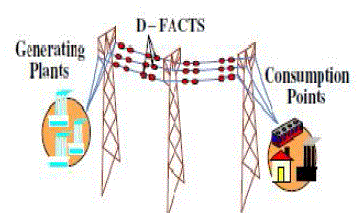 |
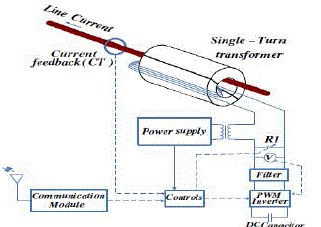 |
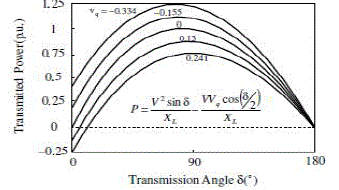 |
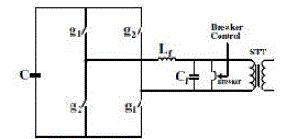 |
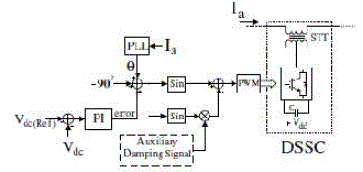 |
| Figure 1 |
Figure 2 |
Figure 3 |
Figure 4 |
Figure 5 |
 |
 |
 |
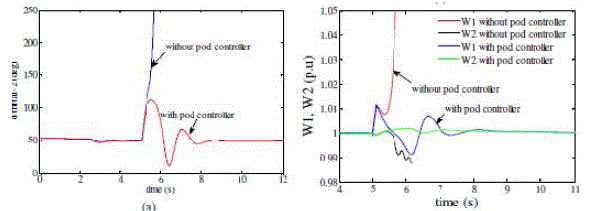 |
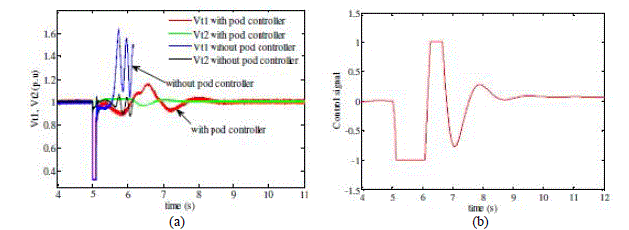 |
| Figure 6 |
Figure 7 |
Figure 8 |
Figure 9 |
Figure 10 |
|
| |
References
|
- P. Kundur, Power system stability and control, Prentice-Hall,N. Y, U. S. A, 1994.
- R.M. Mathur and R.K. Varma, Thyristor-Based FACTS Controllers for Electrical Transmission Systems, IEEEPress and Wiley Interscience, New York, USA, Feb. 2002.
- M. Bongiorno, J. Svensson, and L. Angquist, “On control of static synchronous series compensator for SSRmitigation,” IEEE Trans. Power Electron., vol. 23, no. 2, pp. 735–743, Mar. 2008.
- A.H.M.A Rahim and M.F. Kandlawala, “Robust STATCOM voltage controller design using loop shapingtechnique, ”Electric Power System Research, 68, 2004, pp.61-74.
- J. G. Singh, S. N. Singh, and S. C. Srivastava, “Enhancement of power system security through optimal placementof TCSC and UPFC,” in Proc.IEEE PES General Meeting, pp. 1–6, Jun, 2007.
- M. S. El-Moursi, A. M. Sharaf, and K. El-Arroudi, “Optimal control schemes for SSSC for dynamic seriescompensation,” Elect. Power Syst. Res., vol. 78, no. 4, pp. 646–656, 2008.
- L.J., Cai and I., Erlich. “Simultaneous coordinated tuning of PSS and FACTS damping controllers in large powersystems”, IEEE Trans. Power Syst, vol. 20, No. 1, pp. 294- 300, 2005.
- R. Majumder, B. C. Pal, C. Dufour and P. Korba, “Design and realtime implementation of robust FACTS controllerfor damping inter-area oscillation,” IEEE Trans. Power Syst, vol.21, no. 2, pp.809–816, 2006.
- Divan, D. et al., “A distributed static series compensator system for realizing active power flow control on existingpower lines” IEEE Trans. Power Delivery, vol. 22: pp. 642- 649, 2006.
- D. M. Divan, W. Brumsickle and R. Schneider, “Distributed Floating Series Active Impedance for PowerTransmission Systems,” U.S. Patent Application # 10/679.966.
- P. Fajri, D. Nazarpour and S. Afsharnia, “A PSCAD/EMTDC Model for Distributed Static Series Compensator(DSSC),” Electrical Engineering, ICEE 2008. Second International Conference on Publication, March 2008.1
- Deepak Divan, “Design consideration for series connected distributed facts converter,” IEEE Transmission andDistribution Conference, New Orleans, Louisiana, 2005.
- Deepak Divan, “Distributed Intelligent Power Networks-A New Concept for Improving T&D System Utilizationand Performance,” IEEETransmission and Distribution Conference, New Orleans, Louisiana, 2005.
- Mark Rauls, “Analysis and Design of High Frequency Co- Axial winding Transformers,” MS Thesis, Universityof Wisconsin Man. US,1992
|